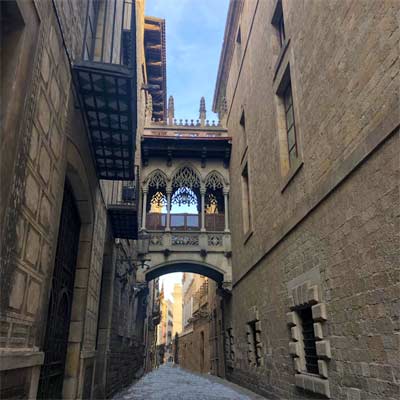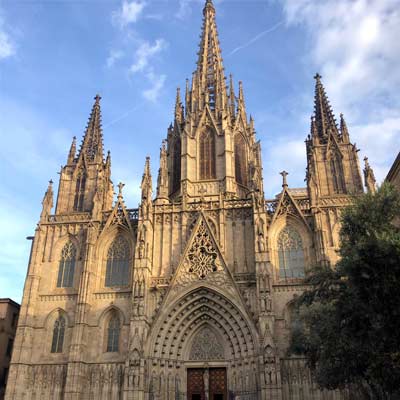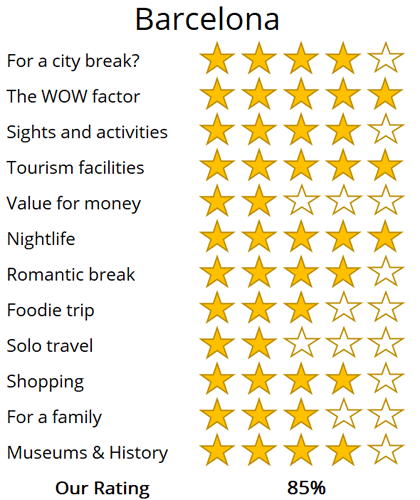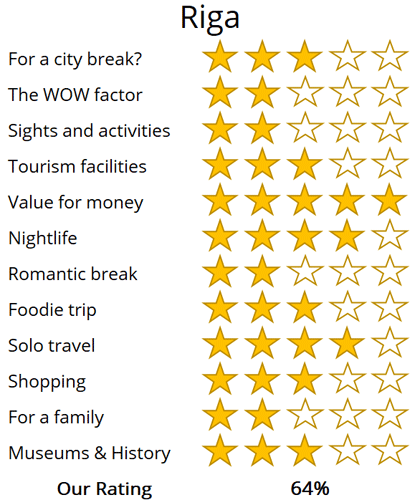WhereToGoForMyHoliday.com
The best destination comparison site!
WhereToGoForMyHoliday.com
The best destination comparison site!
Riga or Barcelona, which is better for your holiday in 2024?
Barcelona and Riga both offer unique and enticing experiences, but which one should you choose for your city break or holiday?
We understand your dilemma. There is an abundance of travel guides for both cities, but few actually comparing them, and advising you which is the better for your trip.
This article will provide our unbiased and independent views of Barcelona and Riga, hopefully making your choice that little easier.
The article is structured into several sections, each of which can be directly accessed through the following links:
• Introduction to the cities
• Scores and ratings
• Which one should I, friends, or family visit?
• When to visit and weather
• Who is the city suited for?
• The perfect 48hours (with map)
• Tourism details (where to stay? airport details?)
Introduction to Barcelona and Riga
Barcelona, the pulsating core of Catalonia, exudes a robust and confident identity that's uniquely its own. As a city that's simultaneously youthful, chic, and forward-thinking, it captures the imagination with awe-inspiring landmarks and vibrant culture.
Nestled between the sparkling sea and towering mountains, Barcelona's dynamic and vivacious character thrives. Yet, the ease with which one can retreat to sun-kissed beaches or the rejuvenating mountain landscapes ensures the city never feels confining.
While Barcelona stands as a premier European destination, it's not without its challenges, such as the impact of heavy tourism and sometimes indifferent service. However, for those willing to navigate these aspects, the city's allure is undeniable, offering a blend of cultural richness and natural beauty that continues to enchant visitors from around the world

The Swedish Gate one of the original gates in Riga’s fortifications
Riga is a cool and collected Baltic capital Bridging both sides of the Daugava River estuary, its laid-back districts effortlessly flit from elegant Art Nouveau to stoic northern cottages built from wood.
But it's the Old Town area that really draws the eye. That's a web of cobbled alleys and hidden squares. Onion domes and Gothic belfries loom overhead in those parts, and hearty Latvian taverns slosh with beers and burst with dumplings in cellars beneath the flagstones.
Be warned that Riga has developed a reputation for stag and hen do weekending. If you travel during the summer, you're likely to encounter at least one group of boozed-up Brits.
But that shouldn't put you off. There are enough craft beer joints, bohemian cafes, and restaurants to go around. What's more, the old guild houses and haunting churches can balance the experience out with a dollop of culture and history.

Riga castle stands along the Daugava River

The Barri Gòtic (Gothic Quarter) is one of the most atmospheric areas of Barcelona
Riga vs Barcelona: City Ratings
Summary
Where would I journey for a personal escape?
Barcelona
Where would I send my parents for a memorable visit?
Barcelona
Where's the ideal destination for my adventurous 19-year-old cousin?
Barcelona
Where should my food-obsessed friend indulge their culinary passions?
Barcelona
Note: The above comparisons are weather-independent and are based on travel during the most opportune times of the year. Details about the ideal travel seasons are elaborated upon later in this article.
In the sections that follow, you'll find a comprehensive comparison between these two fascinating cities. This includes recommendations on the duration of stay, the best times to visit, and tailored 48-hour itineraries for each city.
The final segment delves into practicalities for your travels, such as the best airport to fly into, the optimal districts for your accommodation, and insider tips, for when you come to explore the city.
We hope that you find all of this information useful, in planning your next exciting trip!
Destination details
How long to spend each city?
Barcelona can be fully seen with two intense days of sightseeing, but if you include the beaches, the mountain viewpoints and a more leisurely pace, this leads to the conventional four-day visit.
A trip could be extended by visiting the picturesque Montserrat Monastery and mountains or the attractive coastal town of Sitges. Barcelona is much more suited for a short city break than a longer holiday, and does lack the diversity of day trips as with other destinations.
Riga might be the largest of the three Baltic capitals, but it's still a relatively small city. You can get from end to end in less than 40 minutes in the car, while the districts that are of interest to travellers are all within walking distance of each other.
That helps if you're only planning a short weekend away. Fly-in, fly-out city breaks are totally doable. In fact, a couple of days is what the majority of travellers come for.
If you want to explore for longer, you might want to come during the summertime. Not only can the winters here get downright cold (more on that later), but Riga is close to the some of the most celebrated beach resorts on the whole Baltic coast.

The flamboyant Park Guell, colourful mosaics and whimsical buildings all designed by Barcelona great designer Antoni Gaudí

The skyline of central Riga, with Riga cathedral at the centre
The Baltic summers are a tamer version of the warm season in the south of the continent. It's pleasant here when the temperature squeezes into the low 20s. Then, Riga goes al fresco in earnest.
The cafes on the main squares in the Riga Old Town buzz with life and chatter. There are students and backpackers sharing stories in the beer bar gardens at evening. Those, coupled with the enticing beaches of Jūrmala, are all reasons to plan to arrive sometime between June and September.
Winter in this corner of the continent can be cold. Really cold. It's not uncommon to see whole weeks go by without the thermometers passing single figures, or even positive numbers! Snow is normal, too, so it's wise to pack underlayers and good boots to hit the sightseeing trail anytime from November onwards.
Barcelona is almost a year-round destination, and the best time of year to visit is either early spring or later autumn as this is outside of the peak season, but the weather is still pleasant.
The peak tourist season is July and August, and we suggest Barcelona is best avoided, as it is just too hectic and crowded. The weather is suitable for spending time on the beaches from May until October. The winter months are cooler and possibly wet but there is a less hectic pace around the city.
Barcelona is flashy, energetic and modern. The city has vibrant tourist attractions, without the stuffy atmosphere of many other historic destinations. It generally appeals more to the younger visitor with its heady mix of nightlife, beaches and Instagram ready tourist attractions.
It should be noted that Barcelona is not a cheap city, being the most expensive city in Spain. Barcelona is great for a short stay or a one-day visit, such as from a cruise ship.
Riga does well to distil rich Baltic history, a touch of hedonism, and authentic culture into a bitesize destination. With a population of under 650,000, you're not going to have to navigate a colossal megacity to get stuck into the action here.
You can spend most of your time walking from sight to sight, and enjoy relaxed dining and nightlife scenes to boot. It's one for the more chilled traveller.
The flip side of all that is that Riga isn't some bucket-list-busting capital. It's not got huge, world-famous sights. Instead, it's about enjoying the atmosphere, the regional food, and the intriguing merchant heritage of the place. You also might want to steer clear of the city if you hate the sight of stag and hen dos. They are rampant between June and August especially.

The cathedral of Barcelona is dedicated to Saint Eulalia, and in the adjoining cloister are the 13 white geese commemorating her young martyr death at 13

House of the Blackheads in Riga
Barcelona
Barcelona is a tremendous destination for a 48-hours, and excels as a short-stay destination. Below is an interactive map for 48 hours in Barcelona; day 1 is highlighted in green and day 2 in yellow, with optional sights marked grey.
The first morning would start on the La Rambla the authentic shopping street, which is so popular with tourists and locals alike. For the middle of the day explore the Gothic Quarter, which contains the cathedral and Picasso museum.
For the final part of the head towards the harbour and the lively Barceloneta district, that lies the beaches. For the evening both Gothic Quarter or Barceloneta boasts restaurants, atmosphere and entertainment.

The cable car up to Montjuïc Castle provides wonderful views over Barcelona
For the second day begin by visiting the awe-inspiring Sagrada Familia basilica, with is whimsical towers, intricate carvings and masterpiece of Antoni Gaudí. The theme of Gaudí continues with the next sight, the Parc Guell, which was designed by him and includes delightful mosaic-covered buildings and wonderful views of the city.
The final area to discover is Montjuï, where you can ride the cable car to a stunning or visit the MNAC museum housed in the grand Palau Nacional.
The finale for your time in Barcelona is the inspiring Magic Fountain light show, held at the fountain near the MNAC museum (Wed-Sun peak season).

Did we mention Barcelona has beaches, and that they are amazing!
Hop between the charming plazas and Art Nouveau neighbourhoods of Riga with help from this curated itinerary. It lasts two days and includes most of the mainstream sights and some hidden extras for good measure:
Day 1: Breeze straight into the Riga Old Town. This medieval maze of a district is a fairy-tale place to be. It's also got a glut of sights. Start on the square topped by Saint Peter's Church. The oldest Christian building in the city, it's been rebuilt and reconstructed many a time.
You can scale the 120 or so metres to the top of the spire to get 360-degree views of the river, the capital, and even the Baltic coast. Back on ground level and a few streets over, you can see beautiful Town Hall Square. The most eye-catching building in the city looms on one side.
It's the so-called House of the Blackheads, where rich bachelor merchants held court for several hundred years. Delve inside for exhibits that unravel the enthralling past of the city since the age of the Hanseatic League.
Move northwards through Dome Square to have sunny lunches under the handsome cathedral building. Then push on to Riga Castle. First raised in 1330, it's gilded with additions that were built by the Swedish invaders of Latvia.
As evening closes in, you could opt to join the famous Riga Pub Crawl. They hit a number of underground Latvian taverns and then a pumping club.

The cobbled streets of Riga’s old quarter
Day 2: Hangover or not, you should rise early and make for the western area of Miera Iela. The cracked-plaster façades of the old buildings there herald what's surely the most hipster and creative corner of the city. Students and young professionals are everywhere, and there are some top brunch spots to kick start your morning. Then bear eastwards, back towards the Old Town.
On the way, you'll have to navigate Centrs district. Your first pitstop should be Alberta 12, where a grand edifice decorated with statues of nymphs and floral motifs commands the attention. It's one of the finest examples of the Art Nouveau style for which Riga is famous. Inside, you'll even find the Riga Art Nouveau Museum, which chronicles the architectural and design style from the turn of the century onwards.
Lunch can be had in the new town area to the south – Dzirnavu Iela especially has some charming café-bars and great shopping. The pretty walking paths of Vermane Garden can be perfect for an afternoon stroll if the sun is shining. They will take you all the way to the vibrant Pilsetas kanals garden, the home of the town's padlock-covered love bridge that's in good proximity to some hearty Old Town taverns for dinner.

The freedom Monument – the three stars represent the three regions in Latvia

The Art Nouveau on the Alberta 12
If you can find decent accommodation, then Barcelona is enjoyable for a city break. The main airport of Barcelona is 17km from the city centre and connected by train, but the low-cost airlines may use the very distant Barcelona-Reus (110km south) or Barcelona-Girona (90km north). Neither airport is good for a short city-break, as so much time will be waste travelling.
Accommodation for Barcelona is always in high demand, and you will typically end up paying much more than you originally planned before making any reservations. The summer months can be a real challenge to find good accommodation – book well in advance.

The Sagrada Família is the standout attraction of Barcelona
Once in Barcelona all of the main sights are close and can be easily walked. The standard of food and service at restaurants in the tourist areas varies dramatically, it’s always advisable to check reviews first.
Riga
Riga International Airport is the largest in all of the Baltic states. It's served by flights originating all over Europe, in Russia, and even the Middle East. Bus 22 and plenty of private taxi firms offer connections to the city, though you'll need to be wary of scam drivers who often crank up the price to €80 or more! The trip to the downtown from the terminals usually takes no more than 30 minutes.
You shouldn't need to deal with any public transport on a city break to Riga. The town is nice and compact, so a good pair of shoes and a willingness to walk is usually enough to get around. That said, there are streetcars, buses and minibuses on the same network. Grab yourself an e-talons ticket to use the lot. Each ride costs €1.15 and needs to be renewed if you transfer.
You'll almost certainly want to seek out a hotel in Riga Old Town. That will put you right in the thick of the action. We'd recommend steering clear of Audēju Iela, though.
It's vibrant and lively, but the pumping bars can make it hard to sleep at night. Quieter areas include the northern portion of the district and the streets around Riga Castle.

Riga castle is official residence of the Latvia President
Keep your guard up when walking around Riga, particularly after dark or a few beers. The capital is generally safe, but areas like Maskavas Forštate should be avoided. Pickpockets and petty theft, along with taxi scams, tend to be the biggest dangers of all.

oh we were stuck in the airport!

Copenhagen was a bit expensive...

All we did was drink beer in Brussels...

Muncih was crazy

And we got so burnt!

Remeber that night in Rome

oh we were stuck in the airport

So much fun kayaking

Berlin and that group from Austria!

There was such a view from that church

And we got so burnt!

Munich was eventful, wasn't it!

Such a view from that cathedral in Florence

Lisbon was such so much fun

Last summer was so much fun .... x

Remeber that night in Rome

Lisbon was such so much fun

Such a view from that cathedral in Florence

Munich was eventful, wasn't it!

And we got so burnt!

Remeber that night in Rome

All we did was drink beer in Brussels...

Berlin and that group from Austria!

Can't wait to go back to Dubrovnik

Remember that boat ride in Prague

Copenhagen was a bit expensive...








